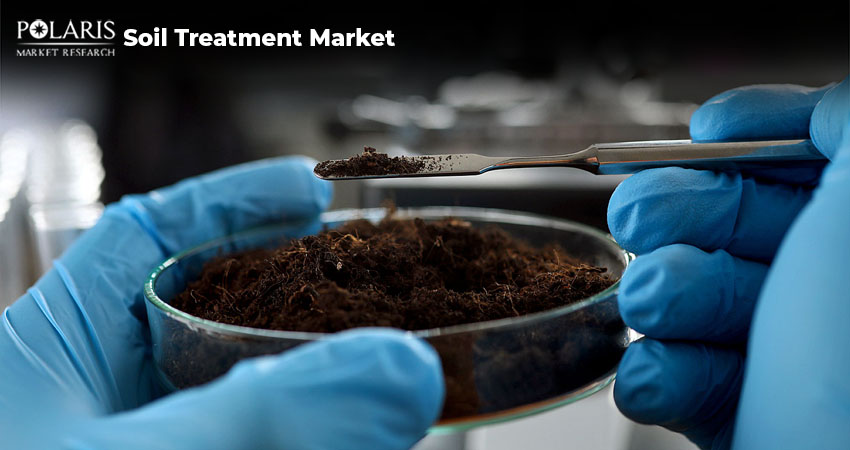Could Better Soil Treatment Be the Solution to Climate-Resilient Farming?

Have you ever wondered why two neighboring farms, growing the same crops under the same climate, yield such different results? The answer often lies beneath the surface, quite literally. Soil is not just dirt; it's a complex ecosystem full of nutrients, microbes, organic matter, and mineral content that determines plant health. As agriculture faces the challenges of climate change, land degradation, and intensive farming, soil treatment has become a critical science.
Understanding how modern soil treatment techniques work can lead us to sustainable food production and improved environmental health. This blog explores the latest methods, benefits, and innovations in soil treatment to help boost fertility, balance pH, and improve crop outcomes. Ready to dig deep into the future of farming? Let’s explore how to treat our soil right!
Understanding Soil Treatment
Soil treatment refers to the various chemical, physical, and biological processes used to improve soil quality and make it more suitable for agriculture or construction. It includes activities such as nutrient amendment, pest control, pH regulation, decontamination, and structure improvement. A well-treated soil not only promotes plant growth but also reduces the risk of environmental pollution and land degradation. Soil treatment can be achieved through various techniques such as soil remediation, soil aeration, soil fertility management, and phytoremediation.
Soil Treatment Market Stats
The global soil treatment market was valued at USD 46.77 billion in 2024. It is expected to reach USD 81.34 billion by 2034, exhibiting a CAGR of 5.7% during 2025–2034.
Emerging Trends in Soil Treatment
Bioaugmentation and Microbial Inoculants
Bioaugmentation and microbial inoculants are gaining traction as sustainable approaches to soil treatment, offering various benefits for remediation and agricultural practices. Instead of relying solely on synthetic fertilizers, farmers now use beneficial microbes (such as nitrogen-fixing bacteria and mycorrhizal fungi) to improve soil nutrient content and plant uptake. These ‘living fertilizers’ help in natural nutrient cycling and support plant resistance against diseases. They enhance the degradation of pollutants by introducing specific microorganisms, while microbial inoculants improve soil health, nutrient availability, and plant resilience.
Precision Soil Mapping & Smart Sensors
Precision soil mapping and smart sensors enable more efficient and sustainable agricultural practices. Precision soil mapping uses technologies like GPS, ground-based soil moisture sensors, UAVs, and satellite imagery to create detailed maps of soil properties. These soil maps help farmers understand the distribution of nutrients, moisture, and other key soil characteristics, allowing them to optimize input application and improve crop yield. Smart sensors, often integrated with Internet of Things (IoT) technology, enable real-time monitoring of various soil parameters, including moisture, nutrients, pH, and temperature.
Use of Biochar
Biochar, a charcoal-like material produced through the pyrolysis of biomass, is gaining popularity as a soil amendment and remediation tool. It's used to improve soil fertility, increase water retention, reduce nutrient leaching, and even remediate contaminated soils. It also acts as a carbon sink, playing a role in climate change mitigation. The trend is towards using biochar for various soil applications, including agriculture, remediation of polluted soils, and improving soil health in general.
Electrokinetic Remediation for Polluted Soils
Electrokinetic remediation (EKR) is an in-situ soil treatment method gaining traction for its effectiveness in removing heavy metals and other contaminants from low-permeability soils. This technique is used in treating contaminated soil near industrial zones. A low electrical current is passed through the soil to remove heavy metals, hydrocarbons, and other toxins, making the land reusable and safe. EKR is environmentally friendly, efficient, and cost-effective for various soil types and contaminants. EKR can be performed directly in the contaminated soil, minimizing the need for soil excavation and transportation.
Benefits of Soil Treatment
Soil Health and Structure: Soil treatment can improve soil conditioning and structure by enhancing aggregation, which is the clumping together of soil particles into larger aggregates. Soil treatment, particularly through practices like cover cropping and compost application, can increase soil organic matter.
Environmental Benefits: Improved soil structure and increased organic matter can help bind soil particles together, reducing the risk of soil erosion caused by wind and water. Soil can store large amounts of carbon, and soil treatment practices like cover cropping and no-till farming can help sequester carbon in the soil, mitigating climate change.
Biodiversity: Healthy soils are home to a wide variety of organisms, including microbes, insects, and earthworms, which play crucial roles in soil health and ecosystem services. Healthy soils provide plants with the nutrients and water they need to grow, leading to stronger, more resilient plants.
Long-Term Sustainability: Healthy soils can reduce the need for synthetic fertilizers and pesticides, contributing to more sustainable agricultural practices. These soils are more resilient to drought, floods, and other environmental stresses. While yield improvement is a primary benefit, soil treatment also improves the quality of crops by providing them with the necessary nutrients for optimal growth.
Did You Know?
In September 2024, Bayer launched its ForwardFarm initiative in India, focusing on regenerative agriculture. This initiative aims to improve soil health, conserve water, and reduce greenhouse gas emissions by demonstrating sustainable farming practices, particularly for smallholder farmers.
Final Thoughts
As agriculture faces mounting pressure from climate change, resource depletion, and growing food demand, soil treatment has emerged as a vital solution. With advancements in biological, chemical, and precision-based techniques, the market is poised for steady growth. Investment in soil health is not just an environmental need but a strategic move for long-term agricultural productivity. The soil treatment market will play a critical role in building a more resilient and sustainable global food system.

